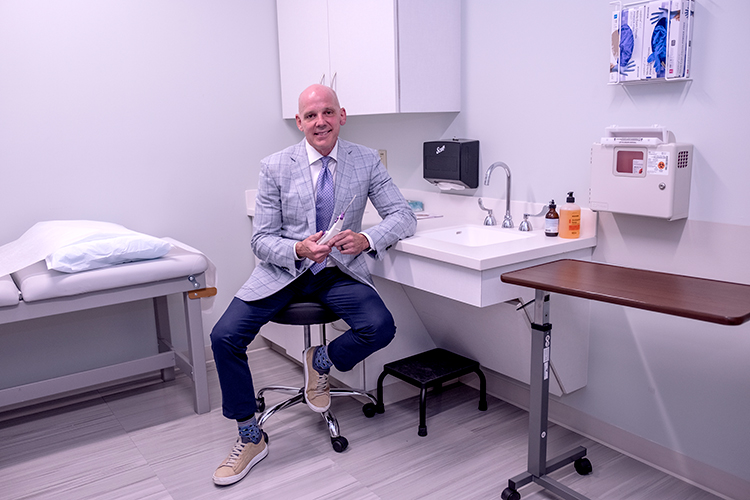
Dr. Paul Paterson, an orthopedic surgeon at Vero Orthopaedics, has perfected an ultrasound-guided technique that makes carpel tunnel surgery much less onerous for patients. He can literally diagnose and operate in the same day in the outpatient office setting.
“Our goal is do everything in one visit to save the patient time, money and discomfort,” Dr. Paterson explained. “Let’s face it, the one thing we all run out of is time and I’m sure everyone has better things to do than to sit in the office waiting to tell me everything is fine [sometime after the operation].
“We want to reduce the barriers that are keeping you symptomatic and make it easy so you don’t have to gut it out. After all, why should you suffer when I can bring you in, evaluate and treat you in one visit?”
Dr. Peterson added that patients don’t even have to go in person for a follow-up visit if everything is good because he can consult with you over the phone.
There are 13 million people in the country at any time who have carpel tunnel syndrome – that annoying pain in the hand that can be mild or so debilitating that it reduces quality of life. Yet there are only about 500,000 surgeries done a year.
Studies have shown that there are at least 2.5 million people who don’t seek surgery simply because they feel their problem is not severe enough to endure a surgery and spend the next 6-to-12 weeks recovering before they can resume their normal activities. They’d rather just suck it up and live with the pain.
But those people might reconsider if they knew about a method of ultrasound-guided carpel tunnel surgery that can be done in one day and require a week or less for recovery.
Carpel tunnel develops when a major nerve in the hand (the median nerve) gets squeezed as it travels through the carpel tunnel in the wrist – the narrow passageway surrounded by bones and ligaments on the palm side of the hand. When the median nerve is compressed, it can cause a tingling sensation, pain, numbness and reduced strength in the hand and arm, making everyday tasks difficult. The pain seems to intensify at night causing people to lose sleep, which can harm their overall health.
“Studies have shown that people with carpel tunnel can lose about two and a half hours of sleep,” Dr. Paterson said. “There is also data confirming that when you lose that kind of sleep at night your blood pressure goes up and you are more likely to be obese. It really does have significant general health concerns. While conservative measures like wearing a hand brace, exercising the hand muscles or getting steroid injections may mask the symptoms, the only cure is surgical intervention called carpel tunnel release.”
Carpel tunnel release involves creating an opening in the ligament in the hand to create more space and relieve pressure on the nerve. Traditionally this procedure has been done with open surgery performed in an operating room under general anesthesia.
Under those circumstances, unfortunately, recovery can take months and may even require additional physical therapy, so it’s understandable why some people delay surgery until the pain is unbearable. But by doing so, they are unwittingly causing more damage to the nerve.
“Fortunately, with a new ultrasound-guided carpel tunnel procedure, I can perform minimally invasive surgery and have you on your way to recovery in about an hour,” Dr. Paterson proclaimed. “And over 90 percent of my patients are sleeping better and returning to their normal activities in just two to four days. That is five to seven times faster than with open surgery.
“With the technology of ultrasound, we as surgeons can get a complete view of the anatomy and see everything in the wrists without the need for a large incision. This allows us to safely cut what we need to and not cut the things we do not want to injure. It only requires one small wrist incision and then with ultrasound guidance a device is inserted and the ligament is released to provide more space for the nerve and tendons.
“Most of the time the incision is closed with just a bandage with no need for stitches. And it can be done in the office or our procedure room under local anesthesia.”
Dr. Paterson has performed approximately 4,000 ultrasound-guided carpel tunnel surgeries in the past five years and finds that his patients are very satisfied with the relief and most appreciative of the time saved.
He foresees the ultrasound-guided carpel tunnel method as the norm in the future, but progress is slowed somewhat, he says, because for some surgeons old habits are hard to break and they are more comfortable doing the conventional open procedure.
Dr. Paterson is a board-certified, fellowship-trained orthopedic surgeon with advanced training and expertise in hand and upper extremity care. After earning a master of science degree in anatomy and physiology at the University of Michigan in Ann Arbor, he received his medical degree and completed his orthopaedic surgery residency at the University at Buffalo Jacobs School of Medicine and Biomedical Sciences. His advanced training in hand and upper extremity care was achieved through a fellowship at Harvard Medical School. He is office is located at Vero Orthopaedics, 3955 Indian River Blvd., Vero Beach. Call 772-569-2330 to schedule an appointment.



